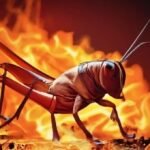Introduction: Crane flies, often mistaken for giant mosquitoes due to their long legs and slender bodies, are common insects found in many regions worldwide. While adult crane flies are harmless and do not bite humans, their larvae, known as leatherjackets, can cause significant damage to lawns, gardens, and agricultural crops by feeding on plant roots. Controlling crane fly populations requires a multifaceted approach that targets both adults and larvae. In this comprehensive guide, we’ll explore a variety of strategies and techniques for getting rid of crane flies effectively and preventing infestations from recurring.
Understanding Crane Fly Behavior: Crane flies belong to the family Tipulidae and are characterized by their long, slender bodies and elongated legs. Adult crane flies are weak fliers and are often seen resting on vegetation or flying clumsily around outdoor lights. Female crane flies lay their eggs in moist soil or turfgrass, where they hatch into larvae known as leatherjackets. Leatherjackets are grayish-brown, legless larvae with tough, leathery skin, and they feed on plant roots, causing damage to lawns, pastures, and crops.
- Cultural Control Methods: Cultural control methods involve modifying the environment to make it less hospitable to crane flies and their larvae. This includes practices such as maintaining healthy turfgrass by mowing at the proper height, aerating and dethatching lawns to improve soil drainage, and avoiding overwatering to reduce soil moisture levels. Consider overseeding bare or thin areas of lawn with resistant grass species to minimize damage from leatherjackets.
- Biological Control Agents: Biological control agents such as nematodes, parasitic wasps, and predatory beetles can be used to target crane fly larvae in the soil. Nematodes are microscopic roundworms that infect and kill crane fly larvae without harming beneficial organisms or the environment. Parasitic wasps lay their eggs inside crane fly larvae, which hatch and consume the larvae from within. Predatory beetles such as ground beetles and rove beetles feed on crane fly eggs, larvae, and adults, helping to reduce population numbers.
- Chemical Control Methods: Chemical control methods involve the use of insecticides to target crane flies at various life stages. Insecticides containing active ingredients such as bifenthrin, lambda-cyhalothrin, or imidacloprid can be applied to lawns, gardens, or agricultural fields to kill adult crane flies and their larvae. Follow the manufacturer’s instructions carefully when applying insecticides, and avoid using them near water sources or in areas where beneficial insects are present.
- Larval Control: Targeting crane fly larvae, or leatherjackets, is key to preventing damage to lawns and other vegetation. Larval control methods include applying biological control agents such as nematodes or parasitic wasps to the soil to target leatherjackets specifically. Additionally, cultural practices such as removing thatch and organic debris from lawns can help expose leatherjackets to natural predators and reduce their survival rates.
- Environmental Modifications: Modifying the environment to make it less attractive to crane flies can help reduce population numbers and prevent infestations. This includes practices such as reducing outdoor lighting at night to minimize attraction to adult crane flies and eliminating standing water sources where female crane flies may lay their eggs. Consider using physical barriers such as row covers or netting to protect vulnerable plants from damage by crane fly larvae.
Conclusion: Controlling crane fly populations requires a comprehensive approach that targets both adults and larvae using a combination of cultural, biological, chemical, and mechanical control methods. By understanding crane fly behavior and biology and implementing proactive control strategies, you can effectively manage crane fly populations and prevent damage to lawns, gardens, and agricultural crops. Remember to monitor infested areas regularly, adapt control strategies as needed, and seek professional assistance if infestations persist. With dedication, patience, and persistence, you can successfully eliminate crane flies and enjoy healthy, thriving outdoor spaces.




